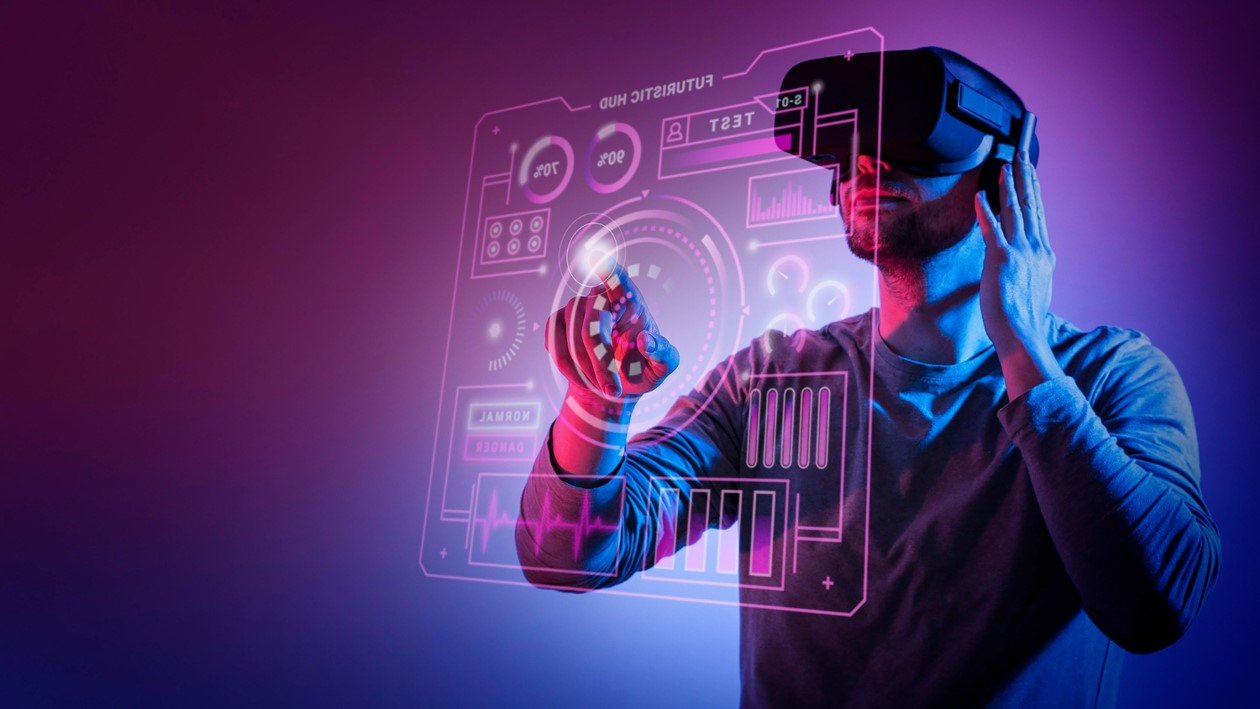In today’s digital age, the term “Exploring the Metaverse” is gaining significant attention. It’s a concept that has the potential to revolutionize the way we interact with technology, socialize, work, and entertain ourselves. This comprehensive guide will delve deep into the Metaverse, exploring its origins, current developments, and promising future.
Explore the Contents
- 1 Exploring the Metaverse
- 2 Understanding the Metaverse
- 3 The Origins of the Metaverse
- 3.1 A Vision from Science Fiction
- 3.2 Neal Stephenson’s “Snow Crash”
- 3.3 Ernest Cline’s “Ready Player One”
- 3.4 The Evolution from Fiction to Reality
- 3.5 The Role of Technology Giants
- 3.6 Emerging Realities
- 3.7 Virtual Reality and Augmented Reality
- 3.8 Building Blocks of the Metaverse
- 3.9 Metaverse Platforms and Companies
- 3.10 Metaverse in Entertainment
- 3.11 Metaverse in Education
- 3.12 Metaverse in Business
- 3.13 Socializing in the Metaverse
- 3.14 Challenges and Concerns
- 3.15 The Future of the Metaverse
- 3.16 How to Get Involved
- 4 Conclusion
- 5 FAQs
Exploring the Metaverse
This comprehensive guide is designed to be your trusted companion as we navigate the Metaverse together. From the basics of virtual reality and augmented reality technologies to the evolution of online gaming and social interactions, we’ll explore the intricate threads that weave this digital tapestry. Whether you’re a curious newcomer or a seasoned explorer, our mission is to provide you with the insights, knowledge, and tools needed to navigate the Metaverse with confidence and purpose. Join us on this exhilarating expedition into the heart of the digital frontier, where new dimensions of existence await your discovery.
Understanding the Metaverse
The concept of the Metaverse is captivating the imagination of people worldwide, and it’s essential to have a clear grasp of what it entails. This section will delve deeper into understanding this evolving digital landscape.
The Essence of the Metaverse
The Metaverse is a multifaceted digital universe that transcends traditional boundaries. It’s not a single entity but a vast network of interconnected virtual spaces, bridging the gap between the physical and digital realms. In essence, it’s a collective virtual shared space that enables users to immerse themselves in a new dimension of digital interaction.
Read More: The Impact of Artificial Intelligence on SEO 2023
Blurring the Lines Between Reality and Virtuality
One of the defining characteristics of the Metaverse is its ability to blur the lines between reality and virtuality. When you enter the Metaverse, you enter a world where the boundaries between real and digital become fluid. It’s a space where you can interact with digital objects, communicate with others, and even engage in commerce, all while feeling a profound sense of presence.
Incorporating Virtual Reality (VR) and Augmented Reality (AR)
To truly understand the Metaverse, it’s essential to grasp the significance of Virtual Reality (VR) and Augmented Reality (AR). These technologies are the building blocks that bring the Metaverse to life. VR immerses users in digital environments, while AR overlays digital information onto the physical world. Together, they provide the tools needed to create immersive experiences.
Creating Digital Avatars
Central to the Metaverse experience are digital avatars. These digital representations of users can be customized to reflect their appearance, preferences, and personality. Avatars serve as your virtual identity, allowing you to navigate and interact with others in this digital realm.
The Power of Interconnected Networks
Interconnected networks play a pivotal role in the Metaverse. These networks enable seamless communication and data exchange between users, applications, and digital environments. The highways connect the various virtual worlds within the Metaverse, facilitating real-time interactions and collaborations.
Sense of Presence
A significant aspect of the Metaverse is the sense of presence it offers. When you’re in the Metaverse, you don’t just observe; you actively participate. You feel you’re truly present within the digital environment, interacting with others and objects as if they were physically around you.
Endless Possibilities
The Metaverse is a realm of endless possibilities. It extends beyond gaming and entertainment, encompassing education, business, healthcare, and art. As technology continues to advance, the potential applications of the Metaverse are limited only by our creativity.
The Origins of the Metaverse

To truly appreciate the concept of the Metaverse, it’s essential to delve into its fascinating origins. At the same time, it may seem like a product of the digital age, but the roots of the Metaverse can be traced back to the imaginative world of science fiction and the visionary minds of authors who dared to dream of immersive virtual realities.
A Vision from Science Fiction
The concept of the Metaverse was first popularized in science fiction literature, particularly in novels like Neal Stephenson’s “Snow Crash” and Ernest Cline’s “Ready Player One.” These authors envisioned a future where individuals could escape into digital realms, creating and living alternate lives within virtual worlds.
Neal Stephenson’s “Snow Crash”
In “Snow Crash,” Neal Stephenson introduced readers to a virtual reality-based Metaverse called the “Metaverse,” where users assumed digital avatars and interacted in a vast digital landscape. This groundbreaking work laid the foundation for the modern-day interpretation of the Metaverse.
Ernest Cline’s “Ready Player One”
“Ready Player One” by Ernest Cline took the concept further by presenting a dystopian future where most of society spent their lives in a virtual universe known as the “OASIS.” This novel emphasized the role of the Metaverse as not only a form of entertainment but also a means of escape and connection.
The Evolution from Fiction to Reality
What was once purely the stuff of science fiction has gradually evolved into a tangible reality. As technology advanced, particularly in virtual reality (VR) and augmented reality (AR), the dream of a Metaverse started to take shape.
The Role of Technology Giants
In recent years, technology giants like Meta (formerly Facebook), Microsoft, and Google have played a significant role in pushing the boundaries of the Metaverse. They have invested heavily in VR, AR, and interconnected platforms, aiming to create the infrastructure necessary for a Metaverse to thrive.
Emerging Realities
Today, we stand at the threshold of a new era, where the Metaverse is not confined to the pages of a novel but is becoming an integral part of our digital landscape. It is no longer a question of “if” but “when” the Metaverse will become a fully realized concept.
In summary, the origins of the Metaverse are rooted in the creative minds of science fiction authors who envisioned a world where the digital and physical realms converged. What began as imaginative storytelling has now transitioned into a transformative force in technology and society. As we proceed in this guide, we will explore the current developments and potential future of the Metaverse, examining how it is reshaping the way we live, work, and interact in the digital age.
Virtual Reality and Augmented Reality
Virtual reality immerses users in a completely digital environment, while augmented reality overlays digital information onto the physical world. Both technologies play a crucial role in the development of the Metaverse.
Building Blocks of the Metaverse
Key elements of the Metaverse include digital avatars, 3D environments, interconnected networks, and a sense of presence. These components come together to create a seamless virtual experience.
Metaverse Platforms and Companies
Tech giants like Meta (formerly Facebook), Microsoft, and Google are investing heavily in Metaverse development. They aim to create platforms and ecosystems where users can access the Metaverse.
Metaverse in Entertainment

The entertainment industry is a major player in the Metaverse, with virtual concerts, gaming, and immersive experiences becoming increasingly popular.
Metaverse in Education
The Metaverse has the potential to transform education by providing immersive learning experiences and global classrooms.
Metaverse in Business
Businesses are exploring the Metaverse for virtual meetings, conferences, and storefronts.
Socializing in the Metaverse
Social interaction is a core aspect of the Metaverse, enabling people to connect and socialize in digital spaces.
Challenges and Concerns
Privacy, security, and digital addiction must be addressed as the Metaverse grows.
The Future of the Metaverse
The future of the Metaverse holds endless possibilities, from improved virtual reality technology to innovative applications in healthcare, art, and beyond.
How to Get Involved
Interested in exploring the Metaverse? We’ll provide tips on how to get started and immerse yourself in this digital frontier.
Read More: Meta Quest Pro review: A next-gen headset for the VR.
Conclusion
As we conclude our journey through the Metaverse, we find ourselves at the crossroads of reality and the digital frontier, where the boundaries between the two continue to blur. The Metaverse, once a realm of science fiction and imagination, has now emerged as a tangible force that promises to redefine how we experience the world.
In our exploration, we’ve uncovered the essence of the Metaverse, understanding it as a collective virtual shared space where digital avatars roam, interconnected networks thrive, and the sense of presence is ever-pervasive. We’ve witnessed how Virtual Reality (VR) and Augmented Reality (AR) technologies have become the building blocks of this new universe, enabling us to transcend the limits of physical reality.
FAQs
What is the Metaverse, and how does it differ from virtual reality?
The Metaverse is a collective virtual shared space, while virtual reality immerses users in entirely digital environments.
Can I access the Metaverse on my smartphone?
Yes, some Metaverse experiences are accessible on smartphones, but VR headsets are recommended for the full immersive experience.
Are there any privacy concerns associated with the Metaverse?
Privacy is a concern, and measures are being developed to address it, such as data protection and identity management.
How is the Metaverse influencing the gaming industry?
The Metaverse is transforming gaming by providing immersive multiplayer experiences and virtual economies.
Is the Metaverse only for tech-savvy individuals, or can anyone participate?
Anyone can participate in the Metaverse, and it’s becoming increasingly user-friendly as technology advances.

